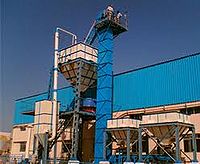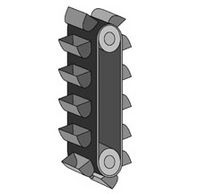Difference between revisions of "Elevators"
| (2 intermediate revisions by the same user not shown) | |||
| Line 1: | Line 1: | ||
[[Category:Elevators]]{{Knoppen}} | [[Category:Elevators]]{{Knoppen}} | ||
[[File:Bucket Elevators_1.jpg|thumb|200px|right|Bucket Elevators]] | |||
[[File:Bucket Elevators_2.jpg|thumb|200px|right|Bucket Elevators 3D model]] | |||
An '''elevator''' is a type of vertical transport equipment that efficiently moves bulk solids between floors (levels, decks) of a building, vessel or other structures. Elevators are generally powered by electric motors that either drive traction cables or counterweight systems like a hoist, or pump hydraulic fluid to raise a cylindrical piston like a jack. | |||
[[File: | |||
An '''elevator''' is a type of vertical transport equipment that efficiently moves | |||
In agriculture and manufacturing, an elevator is any type of conveyor device used to lift materials in a continuous stream into [[bins]] or [[silos]]. | In agriculture and manufacturing, an elevator is any type of conveyor device used to lift materials in a continuous stream into [[bins]] or [[silos]]. | ||
| Line 47: | Line 41: | ||
===19th Century Elevators=== | ===19th Century Elevators=== | ||
From about the middle of the 19th century, elevators were powered, often steam-operated, and were used for conveying materials in factories, mines, and warehouses. | From about the middle of the 19th century, elevators were powered, often steam-operated, and were used for conveying materials in factories, mines, and warehouses. | ||
In 1823, two architects Burton and Hormer built an "ascending room" as they called it, this crude elevator was used to lift paying tourists to a platform for a panorama view of London. In 1835, architects Frost and Stutt built the "Teagle", a belt-driven, counter-weighted, and steam-driven lift was developed in England. | In 1823, two architects Burton and Hormer built an "ascending room" as they called it, this crude elevator was used to lift paying tourists to a platform for a panorama view of London. In 1835, architects Frost and Stutt built the "Teagle", a belt-driven, counter-weighted, and steam-driven lift was developed in England. | ||
| Line 57: | Line 50: | ||
In 1853, American inventor Elisha Otis demonstrated a freight elevator equipped with a safety device to prevent falling in case a supporting cable should break. This increased public confidence in such devices. In 1853, Elisha Otis established a company for manufacturing elevators and patented (1861) a steam elevator. While, Elisha Graves Otis did not actually invent the first elevator, he did invent the brake used in modern elevators, and his brakes made skyscrapers a practical reality. | In 1853, American inventor Elisha Otis demonstrated a freight elevator equipped with a safety device to prevent falling in case a supporting cable should break. This increased public confidence in such devices. In 1853, Elisha Otis established a company for manufacturing elevators and patented (1861) a steam elevator. While, Elisha Graves Otis did not actually invent the first elevator, he did invent the brake used in modern elevators, and his brakes made skyscrapers a practical reality. | ||
In 1857, Elisha Otis and the Otis Elevator Company began manufacturing passenger elevators. A steam-powered passenger elevator was installed by the Otis Brothers in a five-story department store owned by E.W Haughtwhat & Company of Manhattan. It was the first public elevator. | In 1857, Elisha Otis and the Otis Elevator Company began manufacturing passenger elevators. A steam-powered passenger elevator was installed by the Otis Brothers in a five-story department store owned by E.W Haughtwhat & Company of Manhattan. It was the first public elevator. | ||
===Electric Elevators=== | ===Electric Elevators=== | ||
Electric elevators came into to use toward the end of the 19th century. The first one was built by the German inventor Werner von Siemens in 1880. | Electric elevators came into to use toward the end of the 19th century. The first one was built by the German inventor Werner von Siemens in 1880. | ||
Latest revision as of 05:54, 9 April 2014
An elevator is a type of vertical transport equipment that efficiently moves bulk solids between floors (levels, decks) of a building, vessel or other structures. Elevators are generally powered by electric motors that either drive traction cables or counterweight systems like a hoist, or pump hydraulic fluid to raise a cylindrical piston like a jack. In agriculture and manufacturing, an elevator is any type of conveyor device used to lift materials in a continuous stream into bins or silos.
Types
- Belt Bucket Elevators
- Belt Elevators
- Bucket Elevators
- Chain Bucket Elevators
- Chain Elevators
- Circulating Fork Elevators
- Continuous Bucket Elevators
- Covered Bucket Elevators
- Dish Elevators
- Dust Tight Elevators
- Elevator Buckets
- En-Masse Elevators
- Enclosed Flight Elevators
- Flighted Belt Elevators
- Gas Tight Elevators
- Heavy Load Pallet Elevators
- Horizontal Elevators
- Mobile Screw Elevators
- Pendulum Bucket Elevators
- Reciprocating Elevators
- Screw Elevators
- Spiral Elevators
- Tubular Screw Elevators
- Tumblers
- Vertical Elevators
- Vertical Lift Conveyors
- Vertical Transporters
- Vibratory Elevators
History
Primitive elevators were in use as early as the 3rd century BC, operated by human, animal, or water wheel power. In 1743, a counter-weighted, man-powered, personal elevator was built for King Luis XV connecting his apartment in Versailles with that of his mistress, Madame de Chateauroux, whose quarters were one floor above King Luis.
19th Century Elevators
From about the middle of the 19th century, elevators were powered, often steam-operated, and were used for conveying materials in factories, mines, and warehouses. In 1823, two architects Burton and Hormer built an "ascending room" as they called it, this crude elevator was used to lift paying tourists to a platform for a panorama view of London. In 1835, architects Frost and Stutt built the "Teagle", a belt-driven, counter-weighted, and steam-driven lift was developed in England.
Hydraulic Crane
In 1846, Sir William Armstrong introduced the hydraulic crane, and in the early 1870s, hydraulic machines began to replace the steam-powered elevator. The hydraulic elevator is supported by a heavy piston, moving in a cylinder, and operated by the water (or oil) pressure produced by pumps.
Elisha Otis
In 1853, American inventor Elisha Otis demonstrated a freight elevator equipped with a safety device to prevent falling in case a supporting cable should break. This increased public confidence in such devices. In 1853, Elisha Otis established a company for manufacturing elevators and patented (1861) a steam elevator. While, Elisha Graves Otis did not actually invent the first elevator, he did invent the brake used in modern elevators, and his brakes made skyscrapers a practical reality. In 1857, Elisha Otis and the Otis Elevator Company began manufacturing passenger elevators. A steam-powered passenger elevator was installed by the Otis Brothers in a five-story department store owned by E.W Haughtwhat & Company of Manhattan. It was the first public elevator.
Electric Elevators
Electric elevators came into to use toward the end of the 19th century. The first one was built by the German inventor Werner von Siemens in 1880. Black inventor, Alexander Miles patented an electric elevator (U.S. pat#371,207) on October 11, 1887.
Videos

